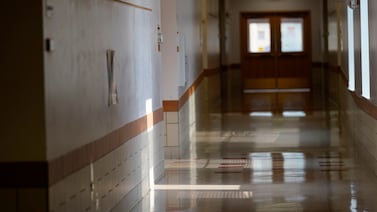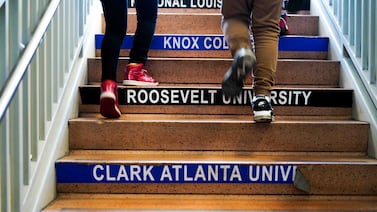Colorado’s graduation rate ticked slightly up for the class of 2023, continuing a long-running trend of rising graduation rates except for a brief dip during the pandemic.
The dropout rate for the class of 2023 was slightly down, which was more good news. But the 2023 dropout rate, which counts how many seventh through 12th grade students disenroll from schools, was still higher than the historic lows the state saw just a few years earlier.
The Colorado Department of Education released graduation and dropout rates for the 2022-23 school year on Tuesday. Statewide, 83.1% of the class of 2023 graduated on time last spring, meaning within four years of starting high school. That was up from 82.3% in 2022.
In a statement, Colorado Education Commissioner Susana Córdova called the 0.8% graduation rate increase “modest.” She credited the hard work of educators, families, and students and nodded to the educational difficulties of the pandemic.
“Given the challenges that our students and educators have faced over the last four years, I am glad that in Colorado we continue to see an improved graduation rate and a decreasing dropout rate,” Córdova said. “It shows students know the value of staying in school and receiving a quality education.”
The statewide dropout rate dipped to 2.1% in 2022-23, down from 2.2% in 2012-22. That’s higher than the 1.8% dropout rate in 2019-20 or the 2% rate in 2018-19, before the pandemic.
Black, Hispanic, and white students all posted higher graduation rates in 2023 than in 2022. But wide gaps by race remain: In 2023, about 90% of white students in Colorado, 80% of Black students, and 77% of Hispanic students graduated in four years.
The class of 2023 were freshman in their second semester of high school when the pandemic began in 2020 and schools were closed. Experts have said that the worst impact on graduation rates may be years ahead, as students who were in elementary school during the pandemic, or switching from elementary into middle school, or middle school into high school, make their way through high school. That’s unless schools are successful in helping students get back on track.
This coming spring, the graduating class will be made up mostly of students who missed out on a typical start to their high school years due to remote learning.
Among the 10 largest Colorado school districts with the highest percentages of students of color, just three districts — Mapleton, Aurora, and Adams 14 — saw a decrease in graduation rates compared to the previous year. Both Aurora Public Schools and Adams 14, in Commerce City, are on a state watchlist for persistently low student achievement.
The largest increases among these 10 districts were in East Otero, Pueblo 60, Weld Re-8 in Fort Lupton, and Denver. East Otero had the highest increase of 6.6 percentage points, rocketing from an 85% graduation rate in 2022 to a rate of 91.6% in 2023.
Rick Lovato, the superintendent for East Otero in southeast Colorado, said he attributes the jump in graduation rates to the district’s alternative education school, which is in its third year.
The school has worked with around 30 students that may not have graduated otherwise, and that “has made a big difference,” he said. East Otero offered some online programs before opening its own campus with in-person courses and workforce readiness programs that help students connect their learning to the workforce.
Denver Public Schools’ graduation rate rose from 76.5% in 2022 to 79% in 2023, the highest rate for the state’s largest district in at least a decade. Its dropout rate remained the same at 3.8%, which meant that about 1,680 students left Denver schools in 2022-23.
Although the graduation rates for white students and Hispanic students in Denver both rose, the gap between the rates widened to more than 13 percentage points in 2023, worsening a problem that has plagued the district and the state for many years. More than half of the students in DPS are Latino, and about a quarter are white.
In Boulder, where gaps by race have also historically been among the largest in the state, the graduation rate for Hispanic students decreased to 81% in 2023 from 81.8% in 2022. By comparison, 94.3% of Boulder’s white students graduated in 2023, which is more than 13 percentage points in difference, a larger gap than in the previous year.
The graduation rate for Latino students at Adams 14′s main high school, which has often been higher than the state rate for Latino students, decreased significantly in 2023 compared to the previous year. Adams City High’s graduation rate for Hispanic students was 84.8%, down from 86.8% in 2022.
Look up your school or district’s four-year graduation rates below:
Melanie Asmar is the bureau chief for Chalkbeat Colorado. Contact Melanie at masmar@chalkbeat.org.
Yesenia Robles is a reporter for Chalkbeat Colorado covering K-12 school districts and multilingual education. Contact Yesenia at yrobles@chalkbeat.org.






